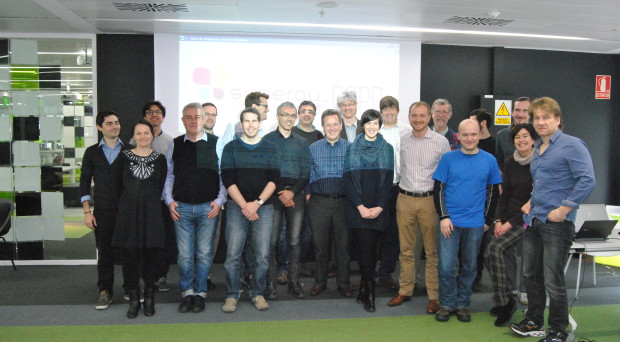
It is widely accepted that chronic diseases represent 77% of the total disease burden on healthcare costs and they have marked consequences on both disability and mortality. This societal and economic burden is only expected to increase over the next decades.
Synergy-COPD has shown that a reduction of healthcare costs will only be achieved through a combined effort in the following two dimensions. Firstly, to increase our physiological and biological understanding of underlying mechanisms of chronic diseases. And, secondly, to implement predictive medicine and clinical decision support solutions that will optimise diagnosis, improve patient management and personalize treatments with an integrated care approach.
To accomplish both these goals in a single effort, we have designed the Synergy-COPD project. In this, we have addressed differences among patients with chronic obstructive pulmonary disease (COPD), in terms of clinical manifestations and/or disease progress.
Using ‘Systems Medicine’
Our hypothesis was that the development of a ‘Systems Medicine’ approach could contribute to cost-effective enhancements of health outcomes. This approach uses computational modeling to understand chronic diseases alongside a technology development which allows the transfer of that acquired knowledge into healthcare.
To this end, Synergy-COPD involves a multi-disciplinary team that includes clinicians, biologists, computational scientists, software developers and mathematicians among others. A brief introduction and overview of Synergy-COPD is available here.
Understanding COPD
Using the Systems Medicine concept to study human body as an integrated whole, we aimed to characterise two sources of heterogeneity in COPD patients. Those are the systemic effects associated with skeletal muscle dysfunction and co-morbidity patterns of these patients. Importantly, we also want to uncover the interplay between them.
Each source of heterogeneity was studied through a different set of tools, but using in all cases the same underlying framework. The framework considers three steps: the first step is the identification of relevant candidate biomarkers; secondly, the use of those candidate biomarkers for the design of health-risk predictive modelling for COPD patients; and, finally, the study of clinical application for those models. You can read about the different modelling methodologies used in the Synergy-COPD project here.
Transferring the knowledge
The Systems Medicine approach requires complex knowledge and large amounts of data to build the models. In order to facilitate the access and use of all this, a set of tools, components of the Digital Health Framework (more on that later), have been developed.
The first major resource generated is an extended publicly available COPD Knowledge Base (COPDKB), that integrates more than 40 public data sources on functional interaction, COPD-specific mRNA profiles and co-morbidity networks connecting more than 6,000 genes/proteins with physiological parameters and disease states.
Furthermore, three mathematical models describing different aspects of systemic effects of COPD were connected to clinical and experimental data.
Finally, the COPDKB has been integrated into the two main tangible outcomes: the Synergy-COPD Simulation Environment (COPDSE), freely accessible at sourceforge. The latter constitutes a first step toward the simulation of individual models. The third outcome is the Clinical Decision Support System (CDSS) that allows practical support to clinicians.
Clinical Applications
The understanding of COPD that we’ve gained through the project should be used to enhance successful deployment and adoption of 4P Medicine – Predictive, Preventive, Personalised and Participatory.
The Clinical Decision Support Systems we developed was embedded into clinical processes with the purpose of bringing novel knowledge into clinical practice and supporting health professionals in the clinical decision making process.
The lessons learned during the project in terms of management of clinical and biomedical data generated the Digital Health Framework (DHF) concept. It is postulated that data exchange and interoperability among different points of care and biomedical data warehouses become crucial and should be facilitated by the implementation of the DHF.
The challenges and opportunities of Synergy-COPD
In the three and a half years of Synergy-COPD, we were faced with several limitations and challenges. One challenge is the synchronisation of vocabulary and definitions among all partners. This highlighted the need to update or revisit the existing biomedical syllabus to prepare the next generation of researchers that will work in even more multidisciplinary environments.
A second challenge was the limiting factor of data availability to study the issues addressed in the project. It was observed that most of the published research reporting -omic data (e.g. transcriptomics, genotypes, DNA Methylation etc.) with a disease-oriented approach does not include context information on co-morbidity. Accordingly, we need to prioritise projects where both -omic information on disease and patient-centred co-morbidities approaches are considered in the reporting. There are also benefits that the approach may provide in the future to personalized medicine in COPD and other complex diseases.
We consider that the deployment of integrated care services supported by information and communication technologies, can contribute to enhance health outcomes in chronic care models without increasing overall costs of the health system, as shown by different initiatives deploying integrated care.
Importantly, healthcare efficiencies can be boosted by promoting a more active role for patients and carers in self-management and co-design of the services; and, fostering cost-effective preventive strategies aiming at slowing the progress of the disease.
These two strategic proposals will require bridging the gap between traditional healthcare delivery at hospitals and primary care units with informal care. A challenging task, but we believe not an impossible one.
Comments